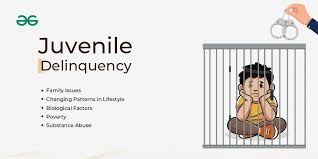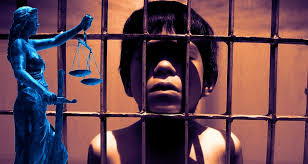Juvenile Delinquency
- ByAdmin --
- 12 Aug 2024 --
- 0 Comments
Juvenile Delinquency
The term "juvenile delinquency" describes youngsters who engage in criminal activity. Delinquent conduct is defined as a person's deviation from the norm in their social life. In other words, a young person may be classified as a juvenile delinquent if their behaviors pose a risk to both him and society.
A person who has not reached the age of eighteen is considered a juvenile, as defined under Section 2(k) of the Juvenile Justice (Care and Protection of Children) Act, 2000.
Laws pertaining to juvenile justice in India:
- The Children Act, 1960, was the first piece of legislation pertaining to juveniles in India. This law was designed to aid children who are in need of care, protection, and treatment and are younger than eighteen. To provide a more thorough framework for child protection, the Juvenile Justice Act (JJA) superseded the Children Act in 1986.
- India's main juvenile justice law framework, the Juvenile Justice (Care and Protection of Children) Act, 2000, went into effect on December 30, 2000.
- In 2006 and 2010, this statute underwent additional amendments. In accordance with the Convention on the Rights of the Child, the age of juveniles was raised from 16 to 18 years old under these revisions.
- It was decided to pass the Juvenile Justice (Care and Protection of Children) Act of 2015. The JJ Act of 2015 seeks to establish a more thorough framework for children's protection, care, and rehabilitation. It presents a restorative justice model that prioritizes child reform and rehabilitation above punishment.
- The JJ Act, 2015 includes provisions for the creation of child welfare committees and juvenile justice boards, among other specialized organizations.
Juvenile delinquency factors :
- Poverty: Being poor as a child can result in a lack of opportunities, resources, and secure housing, all of which can raise the risk of delinquency.
- Peer pressure: Teens may experience an urge to follow in the footsteps of their friends, even if it means breaching the law. Adolescents may be influenced by their peer groups to participate in dangerous and illegal activities in an effort to fit in or rise in social standing.
- Absence of direction and supervision: One of the main causes of the growth in adolescent offenses is the persistent lack of parental or guardian presence. The majority of cases involving juvenile offenses include parents who ignore their child due to their own many problems.
- Family issues: A child's mental, physical, and emotional development will be hampered by ongoing family arguments, which will ultimately result in juvenile criminality.
- Other circumstances: Delinquent conduct in juveniles can also be attributed to other circumstances, such as child labor, traumatic events, illiteracy, mental illness, etc.
The Juvenile Justice Board (JJB)
- The Juvenile Justice Board (JJB) is a court in India that handles cases pertaining to minors. It is a specialist court. The Juvenile Justice (Care and Protection of Children) Act, 2015 created the board.
- Hearing cases involving minors accused of offenses is under the purview of the JJB.
- Two social workers or specialists in child welfare, one of whom must be a woman, make up the board in addition to a magistrate. The board is in charge of making decisions about the juvenile's care and rehabilitation as well as making sure that the juvenile's rights are upheld throughout the legal procedure.
Rehabilitating Juveniles Who Have Offended :
Restoring and rehabilitating juvenile criminals into law-abiding citizens is the primary goal of the nation's juvenile justice system. As a result, the care of young people assumes significance, and establishments such as shelters and observation homes are made with the intention of assisting in their reformation and rehabilitation.
Recently, Thirumoorthy v. State was decided. The Supreme Court ruled, in the case of the Inspector of Police (Neutral Citation: 2024 INSC 247), that the conviction of the accused child, a "child in conflict with law," cannot stand unless the juvenile justice board's preliminary assessment, which determines the child's physical and mental capacity to commit the crime and whether the child should be tried as an adult or a juvenile, is followed as required by the Juvenile Justice Act, 2015.
Conclusion:
To sum up, juvenile delinquency is a severe issue that has an impact on a large number of youth and communities. It describes the illegal actions of kids, often those under the age of 18, who break the law or take part in activities that are deemed dangerous for herself or other people. It's critical to take a holistic strategy to juvenile delinquency that prioritizes early intervention, prevention, and rehabilitation.





0 comments